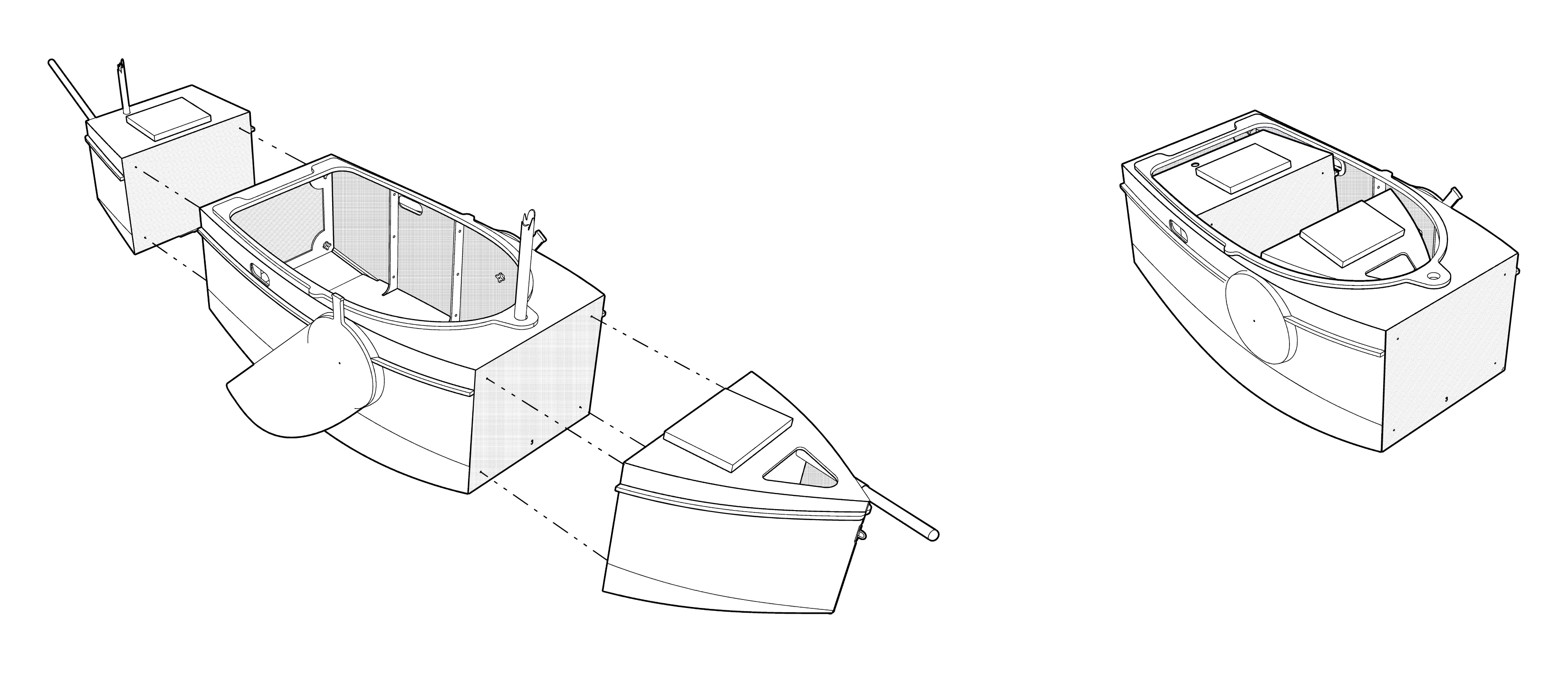
John Harris worked on the Nesting Expedition Dinghy off and on as time allowed and launched the prototype in October 2016.
Read the full write-up on this design here.
Click here for a 2016 update on sailing impressions of the boat.
This tiny cruiser is intended for people who like exploring in small boats but don't have a big shop or storage space. Plans may be purchased and downloaded from this page.
The design began by calculating the smallest possible footprint for a boat that would sail and row well, allow a single person to sleep aboard in some comfort, and carry a week's worth of supplies. John's conclusion was that a 10'6" (3.2m). hull is capable of respectable performance on all points, and in skilled hands can manage rough coastal conditions.
The "Nesting" function means that the bow and stern may be unbolted and stowed in the middle section. This makes it plausible to keep the boat in an apartment, as it will fit through a 32-inch (813mm) doorway. (Barely.) It also fits in John's garden shed, not an incidental consideration.

"It may seem odd to talk about this up front," says the designer, "But STORAGE is a huge problem for everybody. And let's just go ahead and admit to ourselves that most sailboats sit unused for long periods of time. By shrinking beachcruiser features into the smallest practical package, we've eliminated much of the guilt you'll feel when the boat sits idle. A larger boat molders on its trailer in the back yard while you fight the rainwater that collects in the tarp. Or the boats siphons your checking account while stored at a marina. But if your cruising boat is small enough to stand on end in a corner of your garage, the worst thing that happens is that it gets dusty."
Real beachcruiser features are the heart of the Nesting Expedition Dinghy, starting with the cockpit. It will accommodate a 6'3" )1.91m) sailor sleeping on the floorboards. A nylon tent is easily snapped around the cockpit coaming, giving you 52" (1.3m) of sitting headroom. Leeboards, on unusually efficient cantilevered mounts, keep the cockpit clear of clutter. Oars have dedicated storage on deck. Large watertight compartments in the bow and stern will hold far more gear than you could ever carry in a backpack. A big-boat feature is a dedicated self-draining anchor well in the bow, so that your muddy anchor and rode never come near the cockpit.
100 pounds (45kg) of water ballast beneath the cockpit gives her stiffness under sail and stability at anchor. "Any unballasted boat this size has physics fighting comfort," John says. "An ordinary ten-and-a-half-foot plywood skiff is going gyrate whenever the crew shifts their weight. This is okay for an afternoon daysail, but forget using a camp stove! The extra weight increases the polar moment of inertia so that it's not exhausting to live in the thing for a few days."
Not that this boat is intended to sail over the horizon. It's a beach-cruiser, and will be at its best hopping from cove to cove, in mostly sheltered waters. With a draft of six or seven inches, you'll be able to explore rivers and estuaries off-limits to anything larger than a kayak or canoe.
Early tests suggest a boat that is delightful to sail. Deep rocker keeps the wetted surface low and improves handling in choppy conditions. The Nesting Expedition Dinghy pops right up to hull speed and is easy to keep moving. The yawl rig, featuring a furling jib, "solent lug" mainsail, and leg o' mutton mizzen provides numerous sail combinations to suit conditions, from light airs to run-for-shelter gales. The simpler (and slightly smaller) balanced-lug rig is easier to handle and will be a good choice for windy areas.
While the Nesting Expedition Dinghy is responsive and fun to sail, John provides some perspective: "I imagine you could see five knots in the right conditions, but this design is meant for covering distance in comfort, not winning regattas. 30-40 mile days are the target here. 3-1/2 or 4 knots for eight to ten hours. That doesn't seem all that fast until you compare it to what a backpacker can manage on the trail, which is half that, at best. And you can carry four times more gear in the boat than you can in a backpack."
Construction is straightforward, especially for someone with a bit of carpentry background. Detailed plans comprise easy-to-follow 11x17 sheets with plywood layouts and measurements. A fiberglass sheathing is suggested for durability but not a requirement. "My boat acquired a yacht finish as I grew more fond of the design," John says. "But there's a case to be made for meranti plywood and porch paint if you're in a hurry." The hull is built from 6mm and 9mm plywood, with chine logs and sheer clamps. Spars are stock aluminum tubes.
Considerable weight and construction time are saved by eliminating the "nesting" feature; the plans show this option. This also creates a longer cockpit, for taller sailors.
Contact us for current pricing. Two hulls have been completed from kits as of October 2016.
